|
 The
East Orange Police Department recognizes that gangs in this country
are infiltrating our communities, neighborhoods and schools. By reading and understanding
some common indicators of gang activity, your awareness of their presence will significantly
increase. Most importantly, to make you cognizant that your children are not being initiated into a
criminal street gang. Gang identification can be
either a fairly simple task, or daunting in nature. As parents,
teachers, and law enforcement, we have the duty and responsibility to
carefully examine all avenues when determining if an individual is in
a gang, examining the gangster lifestyle, or merely is making a
fashion statement. The
East Orange Police Department recognizes that gangs in this country
are infiltrating our communities, neighborhoods and schools. By reading and understanding
some common indicators of gang activity, your awareness of their presence will significantly
increase. Most importantly, to make you cognizant that your children are not being initiated into a
criminal street gang. Gang identification can be
either a fairly simple task, or daunting in nature. As parents,
teachers, and law enforcement, we have the duty and responsibility to
carefully examine all avenues when determining if an individual is in
a gang, examining the gangster lifestyle, or merely is making a
fashion statement.
Gang
members are
not all black. Indeed, one of the largest street gangs in the Little
Rock area has only a few black members. Several members of this gang
were recently arrested for attempted murder after fire-bombing a home
in an attempt at retaliation. We have also identified several all
female gangs who have their own reputations that are as ferocious as
any of the male gangs. Male gang members privately have even expressed
fear of several of the ladies of the female gangs.
With some of the world's most lucrative drug markets, the
East Coast is ripe for gangs to flourish. There is plenty of
opportunity, potential recruits, and money for savvy gang members to
gain fortune and power. Influences from the West Coast and the
Midwest ("Super Gangs" such as the Bloods, Crips, Latin Kings, and
Gangster Disciples) have become prevalent throughout the eastern
United States.
ALMIGHTY LATIN KING AND QUEEN NATION (AKA LATIN KINGS)
Started in Chicago, Illinois, during the 1940s, this group is made up
primarily of Hispanics. By the late 1970s, the Latin Kings were one
of Chicago's largest and most violent gangs. The group spread to the
East Coast in the 1980s through the prison system, where two inmates
in a Connecticut prison created the Almighty Latin King Nation of
Connecticut. The fine-tuned the concept of the Chicago Latin Kings
and created a well-written King Manifesto, which incorporated
prayers and religious beliefs. This gang, which spread throughout
the Connecticut prison system, quickly became the largest gang in
Connecticut. In 1986, the manifesto was added to in the New York
prison system, and a group called the Almighty Latin King Nation was
formed at the Collins Correctional Institution. Within a few years,
the Latin Kings had spread through the New York state prison system,
and onto the streets. By the early 1990s, New York City had hundreds
of Latin Kings members, and this population grew into the thousands
throughout New York State and nearby New Jersey within a few years.
From 1995 to 1999, the ALKN were the target of a series of RICO
investigations, which resulted in the arrests of hundreds of ALKN
members in charges connected to racketeering and drug distribution.
Today, the Latin Kings on the East Coast remain loosely connected to
the Chicago chapters. The Latin King Nation struggles for unity and
is seemingly finding difficulty in reorganizing to its previous
size.
BLOODS/UNITED BLOOD NATION/EAST COAST BLOOD NATION
The Pirus
first evolved in Los Angeles during the 1970s as a black street gang
which formed for self-protection from the Crips gangs which
predominated in Los Angeles during this era. The Pirus were later
known as the Bloods, because they claimed the color red. Blood gangs
began to spread across the United States during the 1980s, and were
frequently portrayed in music, movies, and other media formats.
The United Blood
Nation, simply called the Bloods, formed in 1993 within the New York
City jail system on Riker's island. Prior to the formation of the
Bloods, the Latin Kings were the most prevalent and organized gang
in the NYC jail system. The Latin Kings and the Netas were large
Hispanic gangs, who began targeting African American inmates with
violence. The African American inmates, organized by some of the
more violent and charismatic inmates, formed a protection group
which they called the United Blood Nation (UBN). UBN emulated the
Bloods street gangs in Los Angeles. Several of the leaders of UBN
then formed eight Blood sets to recruit in their neighborhoods
across New York City. By the mid 1990s, thousands of members of
Bloods street gangs were establishing themselves as a force among
gangs and were continuing steady recruitment. At this time, the
Bloods were more violent than other gangs, but much less organized.
A common ritual among these gangs involved shedding blood, through
stabbings or slashings, as an initiation ritual. By the year 2000,
the Bloods have become the most violent gang on the East Coast.
CRIPS
The Crips
gangs originally formed in East Los Angeles during the 1960s and
1970s. By the mid 1980s, offshoot Crip gangs could be found in most
major cities around the U.S. During the 1980s, several Crip and
Blood gangs developed in Belize (Central America). Gang-affiliated
youth from this country immigrated to the United States during the
late 1980s, especially into East Coast states like New York, New
Jersey, Florida, North Carolina, South Carolina and Georgia. In
1989, Belizian immigrants in New York City formed the Harlem Mafia
Crips in Harlem, as well as several other Crip sets such as the
Rolling 30s Crips, 92 Hoover Crips, and Rolling 60s Crips. During
the late 1990s, Crip gangs were well-established in New York, New
Jersey, North Carolina, Georgia, Connecticut, Florida, Pennsylvania,
and other East Coast areas.
GANGSTER DISCIPLES
According to Gang
Specialist John Guzman of the Chicago Police Department, several
gangs in the Englewood area of Chicago formed the Gangster Disciples
(GD) "nation" of gangs in the 1960s and 1970s.
The 1990s showed an increase in the Gangster Disciple presence on
the East Coast. Data gathered by the National Drug Intelligence
Center (NDIC) indicates that Gangster Disciples can be found in most
East Coast states. The Gangster Disciple's recruitment strategies,
drug networks, and large membership make the GD a force to contend
with around the U.S. When incarcerated, GD are called Brothers (or
Sisters) of the Struggle (BOS). Gangster Disciples is the largest
Folk Nation gang in the U.S.
THE FUTURE
Oddly enough, while crime rates are
down across the United States, gang membership is flourishing. Even
more odd is the rapid increase in gang membership in suburban and
rural areas. Gangs have reached across
geographic,
ethnic, and racial boundaries. Gangs are no longer true to their
origins, but their traditions and identifiers have been distorted,
diluted, and changed as they have relocated across the U.S. Gangs no
longer match their media stereotypes, and law enforcement
professionals need to take the time to understand their individual
community's unique gang problem. The face of the gangster has
changed, and we must be prepared to change with it.
Gang members cast a bleak future for themselves. Gang
membership, although a temporary phase for some youths, severely harms
their future. They socialize strictly with other gang members,
reinforcing their limited view on life. Gang members frequently drop
out of school. This severely limits their chances for a better life.
Some gang members who make it to adulthood may develop patterns of
alcohol and drug abuse. Often, the gang members acquire extensive
police records, limiting their opportunity for employment, turning
them to greater criminal enterprise. Ultimately some gang members are
seriously injured or killed.
Finally, when determining if
someone is a gang member, one has to look at more than just clothing
and jewelry. Called "identifiers", look to see if any
of the following applies to an individual, or your child. Three or
more identifiers may indicate gang involvement.
1.
Does this person have arrests for "gang related" offenses? Arrests
such as, Mob Action, Assault, Drug Charges, Criminal Damage to
Property (vandalism by graffiti) and so forth.
2.
Does your child have lots of money and/or wears expensive clothing
and jewelry---but you know they do not have a job?
3.
Does your child refuse to have their friends come to your home?
4.
Have you found photos of your son or daughter posing with others,
throwing gang signs? (gang members love to pose!)
5.
Are there gang symbols drawn on a person's school books, or
notebooks?
6.
Is gang slang being used in everyday conversation?
7.
Has your child come right out and claimed gang affiliation?
(sometimes all one has to do is ask)
8.
Does your child have any tattoos that show gang affiliation?
9.
Are any other family members of this individual, in a gang?
10. Admits that they are involved in any manner with a gang?
11. Is obsessed with a particular clothing color?
12. Prefers sagging pants or gang clothing?
13. Adopts an unusual desire for privacy and secrecy?
14. Is obsessed with gangster music or videos?
15. Has paint or permanent marker stains on his/her hands or
clothes. Or, is in possession of graffiti paraphernalia such as
markers, etching tools, spray paint, bug spray and starch cans?
16. Shows evidence of physical injures and lies about how they were
received?
17. Have you been
notified by school personnel, law enforcement, or neighbors,
(watching your child get into a car with known gang members) that
your son or daughter may be involved with gangs? The "Not my child!" response may mean you
may be in denial about what's really going on.
18.
Other signs that youngsters may have joined gangs include crude and
elaborate tattoos, females wearing heavy eye make-up and dark
lipstick, fingernails painted a certain color, certain
undergarments, gang-colored shoelaces in their athletic shoes and
specific hairstyles (such as shaving their heads bald, hair nets,
rollers or braids).
-
The above 18 listed indicators are by all means not final or
total---but are a starting place.. But remember:
A) Many gang members,
particularly from larger cities, are opting not to wear
"colors", jewelry, gang tattoos, etc., that are gang
related.
B)
Gang information may appear to be outdated in one region of the
country, but could be new and fresh in another. Gang information
is always changing.
C) Not all gang members are obvious in their dress or manner.
Asian gangs, for example, are not immediately recognizable by their
attire. Also, they may not display gang characteristics while in
school. They are respectful to staff, do not disrupt activities, do
not drop out of school and maintain their grades. In such cases,
gang affiliation is often not known until a criminal incident
occurs.
None of
these warning signs alone is sufficient for predicting gang
involvement, aggression or tendencies toward violence. Also, it
can be detrimental to use these signs as a checklist against
which to measure children. Early warning signs are just that,
indicators that a child may need our help and guidance. These
are behavioral and emotional signs that, when considered in
context, can signal a distraught child. Early warning signs
provide us with a means to examine our concerns and address the
child's needs. Early warning signs allow us to get help for the
child before problems escalate.
New Jersey State
Police Gang Survey By Some N.J. Municipalities
-
-
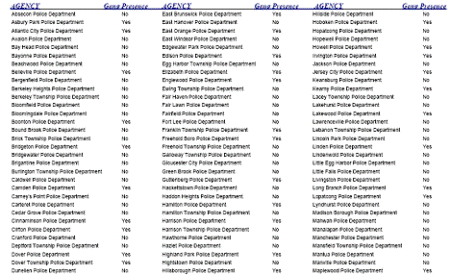
-
-
-
Myths About Gangs
There are
no gang members in East Orange.
Gang members are only ethnic minorities.
Gang members are poor kids.
Gang members are only male.
All gang members wear 'colors'.
All gang members sell drugs.
Gang Definition
-
A group of
persons working to unlawful or anti-social ends - Webster's
Dictionary
-
A group of three
or more persons who:
1. Share a common identity
2. Adopt and use certain signs, symbols, colors engage in
criminal activity
3. A group of people who unite for a common purpose and
engage in violent, unlawful, criminal and antisocial
behavior. They often claim control over certain territory in a
community.
This does not include sport teams, boy's
and girl's clubs, fraternal groups
or organizations that have a common name and who may wear a
particular
uniform articles of clothing.
Street
Gangs
-
Gangs, as we see
them today, were formed for the most part on areas of
Chicago and areas of California, mostly the southern part. Originally formed as
a means of protection for family and neighborhood but
eventually turned to criminal activity as a means of income. Street gang members
carry their gang affiliations to jails where they band together
with the same gang or may join larger, more powerful gangs. Gangs in our area
may assume an existing gang name or use one that may be known
locally.
However, they may adopt signs, colors, symbols, or other identifiers
of a nationally know gang.
Even though we
have currently identified about forty different named gangs in the
local area, they all appear to align with four large major city
gangs:
- Crips
- L.A.
oriented
- Bloods
- L.A. oriented
- Folk
Nation
- a/k/a Hoovers, BGD's, Shorty Folks, Shorties-Chicago
oriented
- People
Nation
- a/k/a Vice Lords, P Stone Rangers, Blackstone Rangers,
Latin Kings-Chicago oriented
Gangs
will sometimes change affiliations. It must always be remembered
that gangs are very fluid in nature and changes occur almost
daily. That again points to the importance of developing local
skill in monitoring the growth and movement of the groups.
Criminal
Street Gang
N.J.S. 2C:44-3:
Three
or more persons associated in fact. Individuals are associated in
fact if they:
-
Have a common group
name or identifying sign, symbol, tattoo or other physical
marking, style of dress
or use of hand signs of association or common leadership
-
Individually or in
combination with other members of a criminal street gang, while
engaging in gang
related activity have committed, conspired or attempted to commit
two or more of the following offenses:
Robbery - Carjacking - Aggravated Assault - Simple Assault -
Aggravated Sexual Assault -
Sexual Assault - Arson - Burglary - Kidnapping - Extortion
Gang
Structure
-
Leadership:
determines
level of criminal activity
-
Hard Core: older,
criminally enmeshed, life members
-
Associate: committed
to gang culture, dedicated to achieving level of recognition
needed to
attain hard core status
-
Fringe: able
to function outside gang, has not committed to a life of criminal
gang activity.
Drifts in and out and seems to lack direction
-
Wanna-Be's:
view
gangs as exciting where they can become somebody. Emulate dress,
graffiti
hand signs, etc. Have not yet been accepted into the gang.
-
Cliques: group
of associate, fringe and wanna be members who gravitate around
hard core
members. Gang within a gang.
Leadership roles
in street gangs are usually not formerly recognized positions.
Leadership is most often assumed by one or more members who
exhibit exceptional antisocial and/or criminal behavior or long
term affiliation. Gangs are usually made up of males ranging in
age from 12 to 22 years old. Members represent all racial and
ethnic groups. Females play an important role. They have been
known to carry weapons, and to transport and hold drugs for male
gang members. Young members are often used to carry, hide, or
sell drugs, or weapons. They are used because of the less severe
legal punishment if they are
apprehended.
Initiations
-
Beat or Jumped
in: Endure a beating by fists, kicks, stomps, or even bats or
clubs
-
Armed Robbery:
Rob
and shoot victim for no reason
-
Drive-by shooting:
Shooting victim(s) from a vehicle
-
Assault:
On
an innocent victim
-
Rape: An
innocent victim
-
Blessed in:
Family
member or reputation vouch for worthiness and loyalty
-
Sexed in:
Female
have intercourse with multiple member who are sometimes HIV
positive
-
Murder:
Required to kill an innocent victim, rival gang member, or
even a police officer
Signs and
Symbols
Symbols
are an important part of the gang culture. They are used to identify
particular gang or to intimidate and disrespect rival gangs. These symbols may be seen
in many forms. Some are known universally, such as a heart, pyramid, walking cane or a five or
six pointed star. These symbols have become nationally known to represent certain gangs. Other symbols
have been created or drawn and have also become well known. In addition to appearing in tattoos,
some may be found in graffiti.
Gang
Jewelry:
Also called
"bling"
in hip-hop parlance,
this type of jewelry is also worn by non-gang members as well. The
jewelry can be either very expensive 14k gold, replete with diamonds
and customed designed, or can be 10k, tinny and potato chip thin. Some
of which can be purchased for as little as $2-$3 each, making it
affordable to elementary school age children. Examples are heavy
gold rope chains, earrings and other large rings. May be expensive
or cheap, but the gaudy type is preferred.
Hand Signs
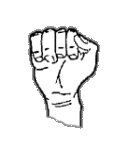

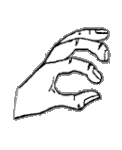
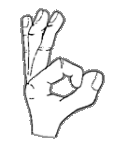 
Gangs use
hand signs as a means of communication, to identify themselves as
a member of a particular gang and to disrespect (dis) rival gang
members. Many gangs have created hand signs to represent each
letter of the alphabet and other signs to
represent a word or phrase. Most members become high proficient in the "art" and
can communicate with others without speaking. Displaying these hand signs is known
as
"throwing"
or
"flashing"
the signs.
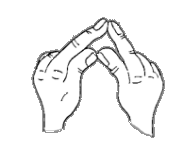
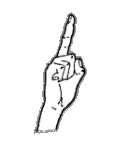

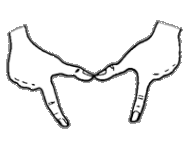
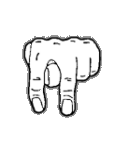
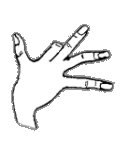
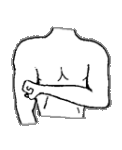
Clothing
Wearing
particular styles, types and colors of clothing, jewelry, shoes
and other items does not mean you are a gang member. It may be a factor in identifying a gang
member.

While
many gang members wear certain types of clothing, one must be very
careful in assuming that a young person is a "gang banger"
simply because they are wearing a Colorado Rockies or Los Angeles
Raiders cap or jacket. Much other criteria is required. Some gang
members have said that they joined up because it was trendy and
cool while others are intimidated into joining for protection.
Other kids who exhibit gang style are, in fact, only "being
cool" by dressing the part.
The uniform of Hispanic gangs is standard and easily
recognizable. Most gang members adopt a basic style that
includes white t-shirts, thin belts, baggy pants with split
cuffs, a black or blue knit cap (beanie) or a bandana tied
around the forehead similar to a sweat band.
Black gang members are
individualistic in their dress. Black gangs tend to identify
themselves by adopting certain colors. The
"Crips"
identify themselves with the colors of blue or black or a
combination of the two.
"Blood"
gangs generally use red accessories, such as caps or bandanas, to
identify themselves.
While clothing alone
cannot positively determine membership in a street gang, color and
style serve to identify each gang. Green can either mean the gang
member is declaring neutrality for the moment or is a drug dealer.
Black is worn by some Hispanic gangs and Heavy Metal Anglo gangs.
Other common gang colors include brown or purple.
Note: Some gangs are
starting to change their clothing style by no longer wearing their
colors in an effort to deceive law enforcement and conceal their
gang affiliation.
Gang clothing styles
can be easily detected because of the specific way gang members wear
their clothing. Examples are preferences for wearing baggy or
"sagging" pants or having baseball caps turned at an angle. Gang
members often prefer particular brands of shoes, pants or shirts.
For example, some gangs like to wear plaid shirts in either blue,
brown, black or red. These shirts are worn loosely and untucked.
Gang graffiti, symbols, messages or gang names can be written or
embroidered on jackets, pants and baseball caps. Other identifying
items include belt buckles with the gangs initials, key chains,
starter jackets (team jackets), and red or blue bandannas commonly
called "rags".
Excessive amounts of
dark clothing or a predominance of one-color outfits, white t-shirts
and levis with upturned cuffs are also indicators of possible gang
involvement.
Weapons
These can
include shaven-down baseball bats, sections of pipe taped at the
ends, spiked wrist bands, mace, knives, or semi-automatic
firearms such as an "Uzi", "AK-47", or "MAC 10."
The
following is a breakdown of ways gangs interpret clothing labels, college names
and sport teams
FILA
- F
(folks) I
(in) L
(love) A
(always)
FLIGHT
- F
(forever) L
(living) I
(in) G
(gangster) H
(hoover) T
(town)
K-SWISS
- K
(kill)
S
(slobs)
W
(when) I
(i) S
(see) S (slobs)
FUBU
-
F
(fuck) U
(u) B (blood)
U
(up)
NIKE
-
N
(niggas) I
(insane) K
(killing) E
(everybody)
ADIDAS
- A
(all) D (day)
I (i)
D
(disrespect) A
(all) S (slobs)
CALVIN KLEIN -
C
(crip or crab)
K
(killers)
MECCA
-
M
(murdering) E
(every) C
(crip) C (child)
A
(alive)
POLO
by Ralph Lauren
- P
(property) O
(of) L
(locs) O
(only)
REEBOK
-
R
(respect) E
(each)
E
(every) B
(blood) O
(O) K
(k)
DUKE - stands
for "Disciples
Using Knowledge
Everyday"
NORTH CAROLINA COLLEGE -
NC
stands for "Neighborhood
Crips"
HOYAS -
stands for "Hoovers
On Your
Ass Slobs"
COLORADO ROCKIES -
CR
stands for "Crips
Rule"
SAINTS -
stands for "Slobs
AINT Shit"
ORLANDO MAGIC - "Magic
stands for "Maniacs
And Gangsters
In Chicago"
LOS ANGELES
RAIDERS
- RAIDERS
stand for "Ruthless
Ass Insane
Disciples
Everywhere
Running Shit"
DALLAS COWBOYS -
COWBOYS stand
for "Crips
Out West
Bangin On
You Slobs"
|
Language
Gangs
have their own way of speaking and writing. They will not use
certain letters or numbers in their speech and writing. They make certain sounds that identify
their gang.
-
Bloods
will not use the letter "C" or the
number "6"
-
Crips
will not use the letter "B" or the number
"5"
Graffiti
-
Graffiti
is known as the newspaper of the streets,
and serve to mark the gang's power and status.
-
It
marks their territory and serves as a warning to other gangs and
police officers that this is their
"turf" and they are not welcome.
-
It
may also be an advertisement for the sale of drugs or a memorial
to a fallen fellow gang member.
-
Not
all graffiti is gang related. "Taggers"
enjoy the creativity of painting on buildings, highways,
trucks, etc.
-
Graffiti
should not be tolerated and in the schools is mandated by the
State to be removed after
notification of the police and then bring photographed.
When a
neighborhood is marked with graffiti indicating territorial
dominance, the entire area and its inhabitants become targets for
violence.
-
A rival gang
identifies everyone in the neighborhood as a potential threat.
-
Unfortunately,
innocent people are often subjected to gang violence by the mere
presence of graffiti in their neighborhood.
-
Without a doubt,
this type of vandalism decreases property values in residential
neighborhoods and creates a sense of concern about community
safety.
Why Gang
Graffiti Is Dangerous
The
purpose of gang graffiti is to glorify the gang. Gang graffiti
is meant to create a sense of intimidation and may increase the
sense of fear within a neighborhood. Gang members use graffiti
to mark their territory or turf, declare their allegiance to the
gang, advertise a gang’s status or power, and to challenge
rivals. Graffiti is used to communicate messages between gangs
using codes with common meaning.
Of greater concern
is the inherent violence associated with gang graffiti. When a
neighborhood is marked with graffiti indicating territorial
dominance, the entire area and its inhabitants become targets
for violence. Anyone in the street or in their home is fair game
for drive-by attacks by rival gang members. A rival gang
identifies everyone in a neighborhood as a potential threat.
Consequently, innocent residents are often subjected to gang
violence by the mere presence of graffiti in their neighborhood.
Tattoos
-
Tattoos
date back to 12,000 BC but records trace back to the Egyptians at
the time the pyramids
were built.
-
Gang
members use them to identify their gang or symbol
-
With
the propensity for violence, some gangs wear and use tattoos as a
means of intimidation
-
Tattoos
are an excellent tool for law enforcement to identify known and
suspected gang members
-
Wearing
unauthorized tattoos can be hazardous to a person's health.
Unauthorized tattoos have
been
cut out
from a person's flesh.
Monikers
The main body of the
placa (main gang name) is the name of the individual or the gang.
Rarely will you see only an individual gang member's moniker
without the gang placa represented as well. This is due to the
fact that many of the monikers are used by all gangs. What the
writer is attempting to do is to get you to picture him relaying a
message or challenge to you. He does this because there is
generally only one of any moniker in each gang. If there are more
than one, it is usually a brother combination. Example: Cruz-
older gang member; Lil' Cruz - younger brother, emulating his
older brother. Placas are challenges when placed on another gang's
wall or territory. What evolves then is a rub-out (the crossing
out of another placa). Eventually a gang war could take place.
These are direct challenges that are directed towards the gang's
machismo and ability to defend their territory.
Some of the more common monikers are:
Angel, Chato, Diablo, Indio, Malo, Blackie, Chango, Dino,
Junior, Mondo, Bobo, Chico, Flaco, Joker, Mosca, Babos, China,
Frog, Lencho, Negro, Bino, Cowboy, Guero, Loco, Neto, Chuey,
Chivo, Huero, Lil' Man, Topo, Oso, Raunchy, Turkey, Papa, Snake,
Tudy, Payaso, Sapo, Viejo, Pato, Spider, Wino, Pee Wee, Seco,
Porky.
Why Young People
Join Gangs
Gang
members join a gang by either committing a crime or undergoing
an initiation procedure wherein they are beaten by fellow gang
members to test their courage and fighting ability. Their
motivations for joining the gang are varied, but usually fall
within one of the following:
Identity or
Recognition
- Being part of a gang allows the gang member to achieve a level
of status he feels impossible outside the gang culture.
Protection
- many members join because they live in the gang area and are,
therefore, subject to violence by rival gangs. Joining
guarantees support in case of attack and retaliation for
transgressions.
Fellowship and Brotherhood
- To the majority of gang members, the gang functions as an
extension of the family and may provide companionship lacking in
the gang member’s home environment. Many older brothers and
relatives belong, or have belonged, to the gang.
Intimidation
- Some members are forced to join if their membership will
contribute to the gang’s criminal activity. Some join to
intimidate others in the community not involved in gang
activity.
Criminal
Activity
- Some join a gang to engage in narcotics activity and benefit
from the group’s profits and protection.
Youth join gangs for the aforementioned reasons including the
excitement of gang activity, peer pressure, status, attention,
family benefit, family tradition, and lack of
realization about the hazards involved. In many cases, young
people are not discouraged from gang involvement by their
parents. Often, parents do not realize that their children are
engaged in gang activity. Although a number of factors add to
the chance of gang involvement, statistics show the typical
youth gang member comes from a single parent family with a
mother as the head of the household or a family with a history
of gang or criminal activity. While a parent is attempting to
provide for the family, often working second jobs or high paying
second and third shift jobs, there is a great amount of freedom
and unsupervised time available to some young people.
Unfortunately, few youths realize the hazards associated with
gang involvement. In many cases, parents are unaware of their
children’s gang activity and are unable to intervene until it’s
too late.
How Are Gangs Identified
Most
gang members are proud of their gang and freely admit to their
membership, even to law enforcement officers. Many openly
display tattoos and brands and adopt a style of dress which
identifies their gang. Their personal belongings are frequently
covered with the gang's name.
Gang members often
use hand signs to identify the gang to which they belong, and
often use nicknames when they are among other gang members. Many
individuals on the border of gang involvement are reluctant to
identify themselves as members. They often claim that their
friends are members, while denying membership themselves.
Borderline gang involvement can be dangerous, because
retaliation and violence involving rival gangs may be directed
either toward gang members or toward their associates.
Distinctions are not made between the two.
Originally,
gangs advertised their existence and posted their messages in
the form of graffiti. This graffiti could be found everywhere, on
walls, fences, subway cars, signs, sidewalks, and even railway
freight cars. Now, with computers being relatively accessible to
anyone, gangs have entered the world of cyberspace. Web sites,
chat rooms, and message boards catering to the gang culture are
popping up on the Internet in increasing numbers.
According
to a recent report by COURT TV, gang members are using the
Internet to discuss crimes in private chat rooms and offer gang
banger wannabes (a misused term) a chance to enlist by posting
membership applications online. It is estimated that that these
gang sites run in the tens of thousands but only 20 to 30 percent
are run by actual gang members.
Gang
Web sites raise issues of free speech and criminal justice
"Gangs.com," Carrie Kirby. San Francisco
Chronicle (www.sfgate.com), January 6, 2001.
Websites displaying the colors and symbols of gangs and
gang life are making their presence known on the Internet.
Law
enforcement officials estimate that about 20 to 30 percent of
the thousands of gang-related Web sites are run by hard-core gang
members. Many fear that publicity about the sites is a threat to
young people. “It’s just another risk for kids---they make
(gangs) look attractive,” says Thomas Kirkpatrick, president of
the Chicago Crime Commission. “They have free e-mail, chat
rooms. It’s another recruiting avenue.”
Others
in law enforcement downplay the recruiting role gang Web sites
may have, since gang membership is based on loyalty, trust and
friendship, difficult sentiments to attain on a Web site. Law
enforcement officials agree that gang Web sites that provide
pictures of expensive cars and scantily dressed women may add to
the gang mystique and could lure some young adults into gang life.
Some
gang Websites based in Chicago were displaying corporate
advertising banners, including Amazon.com and computer seller
Gateway. Once notified, the companies notified the hosting service
which the companies asked the advertising service to remove the
banners. But free speech issues abound, especially for free Web
page services which face legal scrutiny if they are seen as
limiting their users’ free speech.
Anti-gang
groups want gang sites closed down entirely, but law
enforcement officials are not so quick to agree. Some sites have
provided detectives with important information such as photo
evidence, documentation of a gang’s history, its structure and
nicknames of gang leaders. California law states that sentences
may be lengthened when a crime is gang related, and appearing on a
site may qualify as evidence of gang involvement.
Gangs,
today, are forming at an alarming rate. They have been
identified throughout the United States in cities and communities,
large and small, urban and rural. Today, street gang membership
encompasses all races from most socioeconomic levels and is not
limited to larger cities.
The
presence of gangs may be seen everywhere. Gang members do not
represent an invisible empire. They thrive on recognition and are
constantly seeking ways to make their presence known or felt. They
only go unseen when law enforcement personnel, as well as
educators and parents, fail to recognize the signs of gang
activity and an individuals involvement.
Too
often, a community or a department will proclaim that there
are no gangs within the community, stating that there are only a
few youths who are "Wannabes." This term should never be
used. By overlooking the fact that these youths have adopted a
gang name, use gang signs and symbols and commit crimes, these
youths are "Gonnabes." Failing to recognize or denying
the existence of gang activity, whether willingly or through a
lack of gang identification training, drastically increases the
gang's ability to thrive and develop a power base.
It
is extremely important that all law enforcement and
corrections officers familiarize themselves with gangs and gang
member's identifiers. You may accomplish this as an individual or
through departmental group training.
|
What
Can You Do To Prevent Gang Violence
Take
Action! --Everyone must work toward solutions to the gang
problem.
Become
Informed -- The first step in prevention is to learn about gangs, gang
members and their activities. Citizens armed with the basic knowledge of prevention
(awareness-enforcement-education) are better able to avoid becoming victims of
gang violence.
Establish
Neighborhood Watch
-- Contact your local law enforcement agency for
up-to-date information. They can also help you to organize
a Neighborhood Watch program in your community. The gang's
power increases through their use of fear and violence to
intimidate rivals and citizens alike. This tactic can be
countered by citizen action groups such as Neighborhood
Watch. A neighborhood that is united in the goal to stop
gang crime and violence can be an effective force in
curbing gangs.
Cooperate
with Police --
When gang incidents occur in your neighborhood, cooperate
with your local Police Department. Your help may prevent
others from becoming victims of gang violence. Any
information about gang crimes, wanted suspects or any
violent gang-activity should be reported to the police.
Remember, fighting crime and dealing directly with violent
gang members are best left to experts trained to handle
dangerous situations.
Help
Support Your Community
-- Youths loitering after school or "hanging
out" provide a breeding ground for gangs. Communities
can offer young people alternatives to gang involvement.
This includes organized activities for children and
teenagers through recreation departments, schools,
churches and youth organizations. Communities should seek
support from local businesses and industries to employ and
train youths.
Parents
are the first lines of defense in combating the gang
problem. It is up the each parent to show the child that
they are loved. It is not enough to simply say, "I
love you." The child needs parental interaction to
show him or her that you really do love him and you care
about his welfare. Youths join gangs for a variety of
reasons. Many join because they do not have, or do not
feel like they have, a family life. A gang promises to
give this feeling of "family" to the youth.
Other youths join gangs due to peer pressure, excitement,
money, or intimidation. Whatever the reason, a parent
needs to recognize the identifiers and telltale signs of
gang membership in order to make every possible attempt to
keep the youth in, or return him to, his "real
family."
Educators
are equally important in shaping a child's life. Like
the parents, an educator must show the child that they not
only care about them as individuals, but also, about the
future that lies ahead of each of them.
Schools
should not allow gang clothing, colors, or gang signs
and symbols to be worn or displayed on school grounds.
"Zero tolerance" is a policy adopted by many
school districts.
Classroom
discussions about gangs are an excellent means to
convey the proper message to the students. These
discussions can lead to a real learning experience, not
only for the students, but for the educator as well. Like
the parents, the educator, without some knowledge as to
how to identify gangs, will not recognize the signs of
gang activity and therefore lose a valuable tool; a tool
or aid that not only will assist in communications and
interactions with the students, but with other educators,
parents and law enforcement.
Finally
as parents, we need to help our children feel safe, self
confident and respected:
-
Spend
quality time with you children.
-
Become
involved with your children’s school activities.
-
Establish
rules, set limits and be consistent. Know where your
children are at all times.
-
Encourage
good study habits.
-
Become
a model of self-esteem that your children will want
to emulate.
-
Respect
you children’s feelings and attitudes, and help
them develop a strong sense of self-esteem.
Watch for negative
influences that might lead to abuse, gang membership or
delinquent behavior.
|
|





